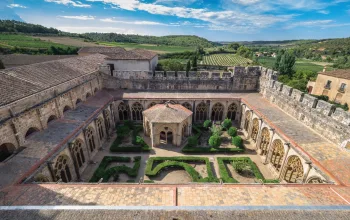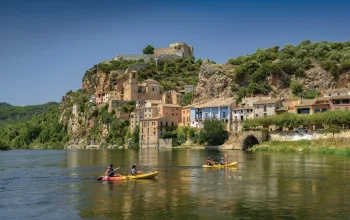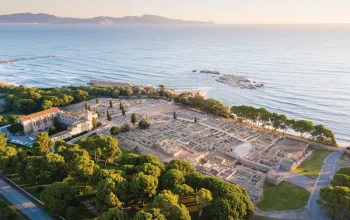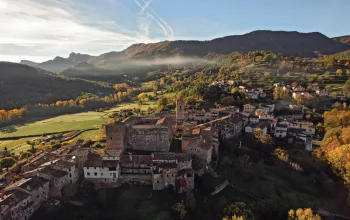Leg 3: Very Close to the Heavens
Route: Lleida to La Seu d’Urgell
Distance: 357km
Duration: 5 stages

Spend a few days in the mountains on a journey through vertiginous landscapes that offer the best starry skies in Catalonia. Travel to the heart of the Pyrenees, hike between glacier lakes, spectacular waterfalls and mountain towns, before discovering Romanesque architecture that is a World Heritage Site. Discover, too, cheeses and artisanal sausages and mountain recipes like the traditional Aranese olha.

Stage 1: Lleida to La Pobla de Segur
Distance: 107km
Before leaving Lleida, explore the cathedral and castle, climbing the bell tower of La Seu Vella to marvel at the views. On the plains outside the city, visit the Castell de Gardeny, which in the 12th century was a stronghold of the Knights Templar.
The panoramic road between Balaguer and Baronia de Sant Oïsme passes through beautiful landscapes with views over the Segre river and the Camarasa reservoir, where you can hike to see cave paintings. Finish the day in the Montsec mountains with a stop at an observatory to learn about the wonders of this Starlight reserve.

Stage 2: La Pobla de Segur to Boi-Taull
Distance: 62km
Spend a day in Catalonia’s only national park, the wonderful Aigüestortes I Estany de Sant Maurici National Park, with its 200 or so glacial lakes surrounded by towering 3,000m peaks. A hike in the Val de Boi is a must – the area is a walkers’ paradise with trails for all ages and fitness levels. It’s also the ideal place to try hearty Pyrennean cuisine, including meat cooked a la llosa – slate-grilled.
In the charming village of Taüll you’ll find historic examples of the Romanesque architecture which has earnt this area a place on the UNESCO World Heritage List.

Don't miss: The magic of winter
Lleida is synonymous with skiing, and there are many options available to practice this sport in the province. The Vall de Boí has the Boí Taüll Resort, which boasts the highest-altitude ski area in the Pyrenees, and the Val d’Aran has the iconic Baqueira-Beret, one of the finest ski resorts in Europe, not just the Pyrenees!
But there are also more modest resorts where visitors can enjoy downhill skiing and cross-country skiing. The list is long and varied: Espot Esquí, Port Ainé, Tavascan, Port del Comte, Virós-Vallferrera, Aransa, Lles de Cerdanya, Sant Joan de l’Erm and Tuixent-la Vansa. Many of these areas also have options to focus on other snowsports, such as dog sledding or snowshoeing.
Stage 3: Boi-Taull to Vielha
Distance: 60km
You are now entering the Val d’Aran, a Pyrennean territory with its own language – Aranese – and own stone-laden architecture, nature and cuisine shaped by its unique geography: unlike other Pyrennean valleys, the Val d’Aran faces the Atlantic and its climate is very different.
Vielha, the Aranese capital is the base for a drive along the Garonna river and a walk to the spectacular Els Uelhs Deth Joeu waterfall. Vielha’s marvellous hospitality is best appreciated on a Pintxo Pote, a tapas bar-crawl through the old town.

Stage 4: Vielha to Sort
Distance: 74km
Head deeper into the Val d’Aran with a visit to some of the area’s charming stone villages, including Arties and Salardú, the latter home to a fine Romanesque church with octagonal tower, frescoes and wooden statue of Christ. For a more relaxing option, you could visit the Banhs de Tredòs, the highest-altitude thermal spa in Europe. From Salardú, a hike is a must to explore the Colomèrs Cirque, the largest lake area in the Pyrenees, with seven glacial lakes. End the day with a delicious Aranese olha, a hearty soup showcasing the region’s cuisine.
Don't miss: Going natural
As well as the Aigüestortes and Estany de Sant Maurici National Park, two natural parks spread over the western part of the Catalan Pyrenees. The 80,000 hectares of the Alt Pirineu Natural Park make it the largest natural park in Catalonia. Within its borders sits another record-breaker, the Pica d’Estats, which is the tallest mountain in Catalonia at 3,143m. The park is home to some endangered species such as the wood grouse, the brown bear and the native Pallaresa lizard, which are not easy to spot.
Its neighbour is the Cadí-Moixeró Natural Park, which protects the two mountain ranges that are linked by the Tancalaporta pass. This is the best place in Catalonia to observe wallcreepers as well as other birds from the mountainous and sub-alpine forests of the Pyrenees, such as the black woodpecker, featured in the park’s logo, or Tengmalm’s owl.

Stage 5: Sort to La Seu d’Urgell
Distance: 54km
The highlight of this stage is the chance to experience the thrills of white-water rafting on the Noguera Pallaresa River, the Catalan capital of rafting, since the 1980s. as well as this high-adrenalin activity, the area also offers opportunities to try hydrospeed, canoeing, canyoning and bungee jumping. If adventure sports are not your thing, the Val d’Àneu offers alternatives such as an ecomuseum and a visit to award-winning cheese producers.
Another interesting stop is at the picturesque town of Gerri de la Sal, with its medieval bridge and 11th century monastery. The leg is rounded off in the town of La Seu d’Urgells, the Catalan capital of cheese!
Don't miss: Aranese Romanesques
There are 33 Romanesque churches in the Val d’Aran, one for each village in the valley. Of all these, there are five that experts consider most interesting. The first is Sant Miquèu, in Vielha, built in the 13th century when the Romanesque period began to use elements from the Gothic period. The second church is located in Bossòst, Era Mair de Diu dera Purificacion, erected in the 12th century.
On the way to Port de la Bonaigua you pass three towns with impressive Romanesque heritage: Arties, Salardú and Unha. The church of Santa Maria d’Arties features a scene of the Final Judgement. The last two churches, Sant Andrèu de Salardú and Santa Eulària d’Unha, also host impressive murals.
To Find out more about this leg of the Grand Tour, go to grandtour.catalunya.com























